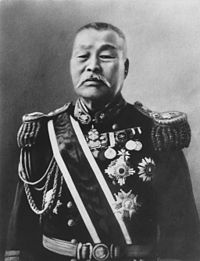- Kabayama Sukenori
-
Count Kabayama Sukenori
Japanese Admiral Count Kabayama SukenoriBorn December 9, 1837
Kagoshima, Satsuma domain JapanDied February 8, 1922 (aged 84)[1]
Tokyo, JapanAllegiance Empire of Japan Service/branch  Imperial Japanese Army
Imperial Japanese ArmyYears of service 1874 - 1903 Rank Major General, Admiral Battles/wars Anglo-Satsuma War
Boshin War
First Sino-Japanese War
oBattle of the Yalu
oBattle of Weihaiwei.Awards Order of the Rising Sun (1st class) Other work Governor-General of Taiwan
Privy Council
Home Minister
Education MinisterIn this Japanese name, the family name is "Kabayama".Count Kabayama Sukenori (樺山 資紀, 9 December 1837 – 8 February 1922) was a general in the Imperial Japanese Army and an admiral in the Imperial Japanese Navy. He later became the first Japanese Governor-General of Taiwan during the island's period as a Japanese colony. He is also sometimes referred to as Kabayama Motonori.
Contents
Biography
Born in Satsuma domain (modern day Kagoshima Prefecture) to a samurai family, Kabayama fought in the Anglo-Satsuma War and the Boshin War.
In 1871, he enlisted in the new Imperial Japanese Army and was accepted with the rank of major due to his previous combat experience. He was one of the defenders of Kumamoto Castle during the Satsuma Rebellion against his former Satsuma countrymen. He was subsequently promoted to colonel, and then major general, and placed in charge of the Tokyo Metropolitan Police.
In 1883, Kabayama changed from the army to the navy, becoming taifu (senior vice minister) of Navy with the rank of rear admiral, and was also ennobled with the title of viscount (koshaku) under the kazoku peerage system. The following year he was promoted to vice admiral.
Kabayama became Vice Navy Minister in 1886. He visited the United States and Europe from 25 September 1887 to 19 October 1888. He then served in several positions before being appointed Navy Minister under the first Yamagata and Matsukata cabinets from 1890-1892. Although not a politician, he spoke out harshly against representative democracy and civilian influence on the government in a speech Banyu Enzetsu made during the second Imperial Diet session. He retired in 1892.
During the First Sino-Japanese War, Kabayama was recalled from the reserves and accepted a field command, and was present at the Battle of the Yalu and Battle of Weihaiwei. It states something of his personality to note that he ordered his flagship, the lightly armed passenger liner Saikyo to charge the Chinese fleet at the Battle of the Yalu River.[2]
Kabayama was commander of the Japanese invasion force for Taiwan. On 10 May 1895, he was promoted to full admiral and became the first Japanese Governor-General of Taiwan, being responsible for moving the seat of government to Taipei. He was elevated to hakushaku (Count) on 5 August 1895 and also awarded the Order of the Rising Sun (first class).
Despite his best efforts to stabilize Japan's rule over Taiwan, his 13 months term as Governor-General were not peaceful. From December 1895 to January 1896, uprisings surfaced in many parts of the island, and he was forced to request reinforcements from home. In the ensuing action, 2800 Taiwanese were killed. Kabayama was succeeded by Lieutenant General Katsura Tarō.[3]
After his return to Japan in June 1896, Kabayama subsequently served on the Privy Council, as Home Minister under the 2nd Matsukata Cabinet, and Education Minister under the 2nd Yamamoto cabinet.
Kabayama retired again from duty in 1910. His grave is at the Somei Reien Cemetery, in Sugamo, Tokyo.
References
Books
- Ching, Leo T.S. (2001). Becoming Japanese: Colonial Taiwan and the Politics of Identity Formation. University of California Press. ISBN 0-520-22553-8.
- Keene, Donald (2005). Emperor Of Japan: Meiji And His World, 1852-1912. Columbia University Press. ISBN 0-231-12341-8.
- Paine, S.C.M. (2001). The Sino-Japanese War of 1894-1895: Perception, Power, and Primacy. Cambridge, MA: Cambridge University Press. ISBN 0521617456.
- Sims, Richard (1998). French Policy Towards the Bakufu and Meiji Japan 1854-1894. RoutledgeCurzon. ISBN 1-873410-61-1.
External links
- National Diet Library. "Kabayama Sukenori". Portraits of Modern Japanese Historical Figures. http://www.ndl.go.jp/portrait/e/datas/58.html. Retrieved 2006-08-14.
- Nishida, Hiroshi. "Materials of IJN: Kabayama, Sukenori". Imperial Japanese Navy. http://homepage2.nifty.com/nishidah/e/px00.htm#a002. Retrieved 2007-08-03.
Notes
Political offices Preceded by
Saigō TsugumichiMinister of the Navy
May 1890 - Aug 1892Succeeded by
Nire KagenoriPreceded by
noneGovernor-General of Taiwan
May 1895 - Jun 1896Succeeded by
Katsura TarōPreceded by
Itagaki TaisukeHome Minister
Sept 1896 - Jan 1898Succeeded by
Yoshikawa AkimasaPreceded by
Inukai TsuyoshiMinister of Education
Nov 1898 - Oct 1900Succeeded by
Matsuda MasahisaMilitary offices Preceded by
Nakamuta KuranosukeChief of the Imperial Japanese Navy General Staff
Jul 1984 - May 1895Succeeded by
Itoh Sukeyuki|}

Japanese Governors-General of Taiwan Kabayama Sukenori • Katsura Tarō • Nogi Maresuke • Kodama Gentarō • Sakuma Samata • Andō Teibi • Akashi Motojirō • Den Kenjirō • Uchida Kakichi • Izawa Takio • Kamiyama Mitsunoshin • Kawamura Takeji • Ishizuka Eizō • Ōta Masahiro • Minami Hiroshi • Nakagawa Kenzō • Kobayashi Seizō • Hasegawa Kiyoshi • Andō RikichiCategories:- Japanese generals
- Imperial Japanese Navy admirals
- Ministers of the Navy of Japan
- Governors-General of Taiwan
- People from Satsuma Domain
- People of the Boshin War
- Kazoku
- 1837 births
- 1922 deaths
- People of the First Sino-Japanese War
- People in Meiji period Japan
- Shimazu retainers
Wikimedia Foundation. 2010.

